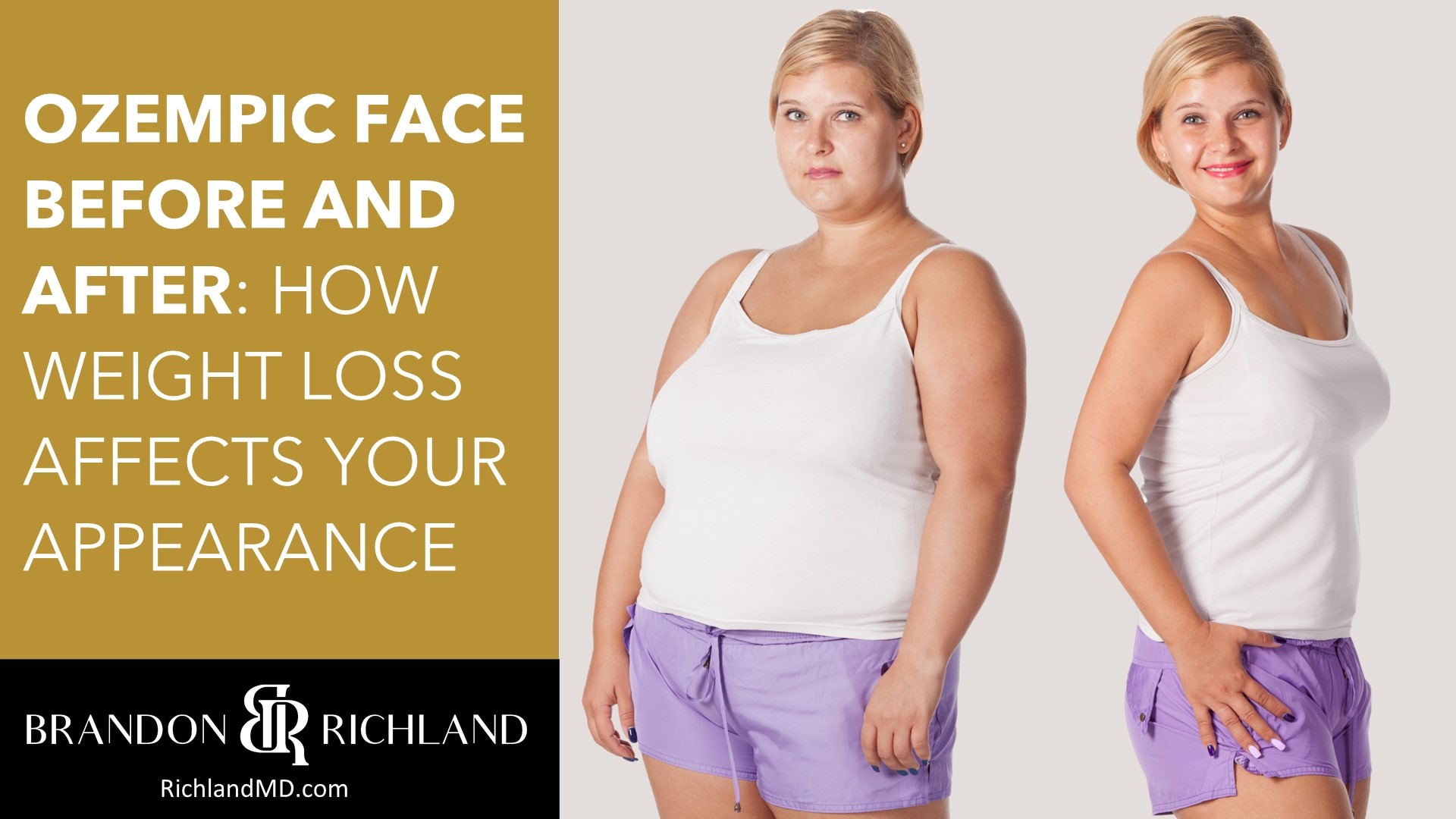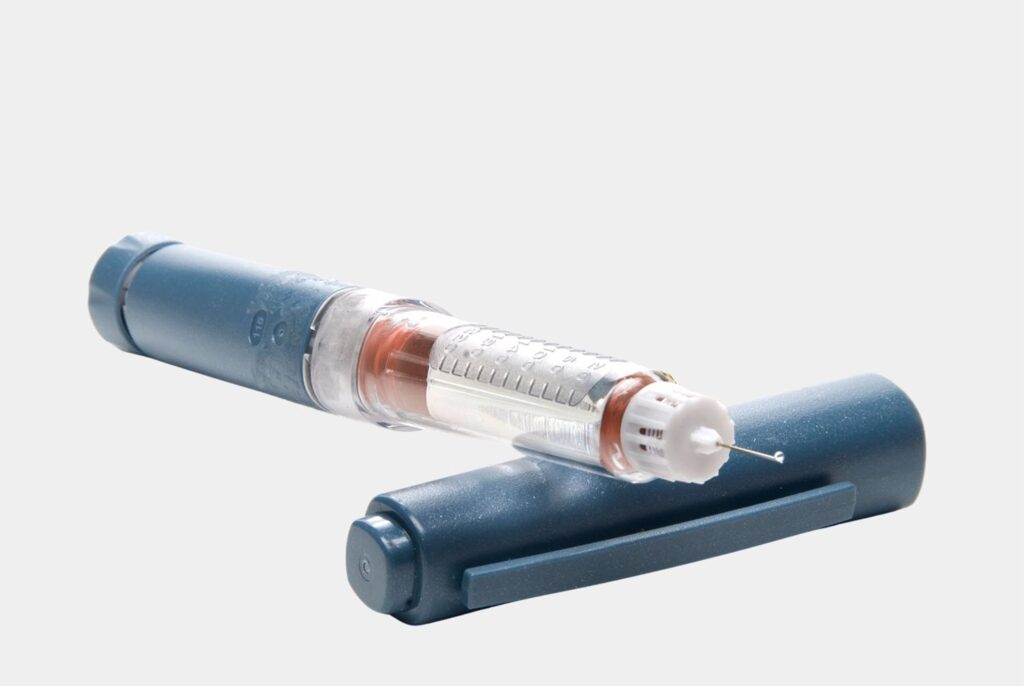Published by Dr. Brandon Richland, MD

The use of Ozempic, a medication originally for type 2 diabetes, has gained popularity due to its weight loss effects. With significant weight loss, some users notice changes in facial appearance, often termed as “Ozempic face.” These changes typically include sagging or loose skin as a result of rapid weight loss. Understanding how weight loss affects facial features can help people prepare for these possible changes.
Key Takeaways of Ozempic Face Before and After
- Rapid weight loss using Ozempic can cause noticeable facial changes.
- Reduced collagen and skin elasticity affect how the face appears after losing weight.
- Non-surgical treatments may help address skin changes linked to Ozempic use.
What Is Ozempic?
Ozempic is a medication that’s gained attention for its effectiveness in managing type 2 diabetes and aiding weight loss. It helps regulate blood sugar and can support those trying to lose weight by targeting key hormonal pathways.
Understanding Semaglutide and GLP-1
Semaglutide is the active ingredient in Ozempic. It’s part of a class of drugs known as GLP-1 receptor agonists. GLP-1, or glucagon-like peptide-1, is a hormone in the body that plays a vital role in maintaining blood sugar levels.
When someone takes semaglutide, it mimics the action of GLP-1, which encourages insulin release. This helps lower blood sugar levels and slows digestion, reducing hunger. Because of these effects, medications like Ozempic are used not only for diabetes management but also for weight control.

Weight Loss and Its Impact on the Face
Significant weight loss can bring about noticeable changes in the face, affecting its structure and appearance. These changes are primarily due to shifts in facial fat distribution and alterations in skin elasticity and collagen levels.
Facial Fat Distribution
When a person loses a lot of weight, the reduction in body fat also impacts the face. Facial fat is important for filling out facial features and maintaining youthful appearance. As fat decreases, the face can look hollow or gaunt. This change is sometimes referred to as Ozempic face.
This alteration might bring about loose, sagging skin around the cheeks and jawline. Despite the benefits of weight loss for overall health, these changes in facial fat distribution are considered a cosmetic concern by many.
Collagen and Skin Elasticity
Collagen plays a key role in keeping skin firm and elastic. During rapid weight loss, the collagen levels can decline, making the skin less resilient. This can result in sagging and less firm skin around the face. Without the support from facial fat, these changes can be more pronounced, leading to a more aged appearance.
Skin elasticity is affected as well. When the skin stretches due to weight loss, it may not snap back easily, especially if collagen levels are lower. Addressing these issues often involves treatments designed to restore collagen and improve skin’s elasticity to enhance facial appearance.
Typical Changes in Facial Appearance
Rapid weight loss can dramatically change a person’s facial appearance. These changes often involve the reduction of facial fat, leading to a more defined but sometimes older-looking face. Both hydration and nutrition can play significant roles in maintaining a youthful appearance during this process.
Before and After Rapid Weight Loss
When someone experiences rapid weight loss, it often leads to a noticeable decrease in facial fat. This can result in a more sculpted look, highlighting cheekbones and jaw lines. However, this can also create a gaunt appearance, as there is less fat to fill out the skin.
Older individuals may see more pronounced effects because of lower collagen levels. When this natural protein decreases, skin may sag or appear hollow. Most of these changes are more evident if weight loss happens quickly, as the skin has less time to adjust.
Young people might not see such drastic changes due to higher levels of collagen and elastin. These proteins help maintain a smoother and more elastic skin structure, reducing the appearance of lines or sagging.
The Role of Hydration and Nutrition
Hydration is key to keeping skin looking healthy and fresh. Drinking enough water can help maintain skin elasticity and prevent dryness, which can make fine lines more visible. Proper hydration ensures that the skin is plump and resilient despite weight loss.
Nutrition also plays a vital role. Eating foods rich in vitamins and minerals, like fruits and vegetables, supports skin health. This type of diet can boost collagen production and improve elasticity, reducing signs of aging.
Including protein-rich foods can help as well, as they are essential in the maintenance and repair of body tissues, including skin. Thus, a balanced intake of nutrients aids in maintaining a brighter and more youthful look.
Collagen Production and Age-Related Changes
Collagen plays a crucial role in maintaining skin elasticity and firmness. As individuals age, collagen production slows, leading to visible signs like wrinkles and changes in skin texture. Various skincare practices can support collagen and combat these age-related shifts.
Wrinkles and Lines
As people grow older, wrinkles and lines become more pronounced due to decreased collagen levels. Collagen provides structure, and its reduction over time leads to sagging skin and the formation of wrinkles. Areas frequently showing these signs are the forehead, eyes, and mouth. Repetitive facial expressions can deepen these lines.
The skin’s aging process is affected by environmental factors, lifestyle choices, and genetics. Protecting against sun exposure and staying hydrated are important ways to reduce the impact of collagen loss. Using products that encourage collagen production can also help maintain skin elasticity, possibly delaying visible signs of aging.
Skin Care and Antioxidants
Effective skin care is essential to stimulate collagen production. Antioxidants play a significant role in protecting skin cells from damage. Ingredients like vitamin C are known for boosting collagen synthesis. This helps improve skin firmness and texture, which can make lines and wrinkles less noticeable.
Incorporating antioxidant-rich foods like berries and green vegetables into the diet benefits not only the skin but overall health. Topical products with antioxidants can protect the skin from harmful free radicals. A consistent skincare routine with moisturizers and serums designed to enhance collagen can promote a healthier appearance, reducing the signs of aging.
Ozempic Face: Understanding the Phenomenon
Ozempic face describes facial changes that occur due to rapid weight loss from using Ozempic. Many people notice a gaunt or hollowed appearance due to the loss of facial fat, which can alter the structural look of the face.

Hollowed Appearance and Facial Fat Loss
Using Ozempic can lead to significant facial fat loss. This loss often results in a more hollowed appearance, as fat previously provided facial volume and softness. Fat acts as a natural cushion, offering youthful contours.
When this fat diminishes, the skin can sag, affecting how someone looks. The diminished volume creates a gaunt appearance, making features appear sharper and sometimes aged. Younger skin may better adapt due to higher collagen levels, but older skin might struggle more.
Skin elasticity plays a significant role. Elastic skin can adjust better to changes, while less elastic skin may not adapt as well. This contrast often explains why some people experience more noticeable features after losing weight with Ozempic.
Managing Expectations with Weight Loss Medication
Managing expectations is essential when using weight loss medications like Ozempic. While it can aid in shedding pounds, it may also lead to noticeable facial changes. Individuals should be aware that these changes are possible and consider them part of their overall weight loss journey.
Preemptive measures can help. Some might seek treatments to counteract the effects, such as boosting collagen production or maintaining skin health with professional skincare routines. Discussions with healthcare providers can offer guidance on slowing down these changes.
It’s crucial to balance health goals with potential cosmetic changes. By understanding the effects, individuals can better navigate the journey, keeping both desired body weight and facial appearance in mind.
Diet and Exercise Considerations
Maintaining a healthy appearance after weight loss involves making good choices in both diet and exercise. A balanced diet supports skin health, while exercise helps in facial toning and overall well-being.
A Balanced Diet for Skin Health
A balanced diet plays a crucial role in maintaining skin health, especially during weight loss. Foods that are high in collagen, like bone broth, can help improve skin elasticity. Including vitamins such as A, C, and E, found in fruits and vegetables, is important for skin repair and maintenance.
Protein is another important aspect of a healthy eating plan. It helps in building and repairing body tissues, including skin. Lean meats, beans, and legumes are excellent sources of protein that support skin structure.
Staying hydrated is essential. Drinking plenty of water helps the skin maintain its moisture and elasticity. Avoiding processed foods and sugar-rich snacks can also prevent inflammation, which negatively impacts skin health.
Exercise for Facial Toning
Exercise is key for facial toning and maintaining a youthful appearance. Routines that focus on facial muscles can help tighten and lift the skin, reducing sagging.
Activities like yoga or Pilates can improve blood circulation, which nourishes the skin from within. Cardiovascular exercises also boost heart health and blood flow, contributing to a healthy glow.
Incorporating resistance training into a routine helps maintain muscle mass, which is vital for a toned appearance. A mix of bodyweight exercises and light weights can be effective.
Consistency in these physical activities leads to more noticeable improvements in facial tone and skin appearance, making them a valuable part of a healthy lifestyle.
Frequently Asked Questions about Ozempic Face Before and After
1. What Are The Common Changes In Facial Appearance After Using Ozempic For Weight Loss?
When using Ozempic, some people notice a gaunt or aged look. This is often due to the rapid loss of facial fat, which can cause skin to sag and make cheeks appear hollow.
2. Can The Effects Of Ozempic On Facial Features Be Reversed, And If So, How?
Reversing these changes might involve treatments like fillers or cosmetic procedures to restore volume. Consulting with a cosmetic dermatologist can provide personalized options to regain a more youthful appearance.
3. What Should One Expect In Terms Of Facial Aging After Significant Weight Loss With Ozempic?
Individuals might experience accelerated signs of aging, such as wrinkles and sagging skin, especially if weight loss is rapid. Maintaining a healthy skincare routine can help manage these effects over time.
4. Are There Any Tips To Prevent Undesirable Facial Changes When Taking Ozempic?
To minimize unwanted changes, a gradual approach to weight loss is recommended. Staying hydrated, eating a balanced diet, and exercising can also contribute to skin elasticity and overall appearance.

Conclusion and Summary of Ozempic Face Before and After: How Weight Loss Affects Your Appearance
Addressing changes in facial appearance after rapid weight loss is essential for those seeking long-term confidence in their look. Treatments such as dermal fillers can restore lost volume and improve facial contours. For more extensive solutions, a fat transfer can offer natural, lasting results by replenishing depleted areas with the body’s own tissue. Additionally, non-invasive procedures are effective for individuals with moderate skin laxity, helping to firm and lift sagging areas without surgery.
Managing facial sagging after weight loss requires a personalized approach, combining skincare routines and cosmetic treatments. By focusing on solutions that enhance facial skin elasticity, patients can achieve a youthful, revitalized appearance while maintaining the health benefits of their weight-loss journey.
Please note that this article is intended for informational purposes only and should not be construed as medical advice. Before making any changes to your treatments, please consult with your healthcare provider to discuss the appropriateness and safety of such changes.
Ready For Your First-Class Cosmetic Experience in Orange County (OC) California (CA)?
Are you located in one of these Orange County (OC) / Southern California cities?
Aliso Viejo, Anaheim, Brea, Buena Park, Costa Mesa, Coto de Caza, Cypress, Dana Point, Fountain Valley, Fullerton, Garden Grove, Huntington Beach, Irvine, La Habra, La Palma, Laguna Beach, Laguna Hills, Laguna Niguel, Laguna Woods, Ladera Ranch, Lake Forest, Los Alamitos, Mission Viejo, Newport Beach, Orange, Placentia, Rancho Santa Margarita, San Clemente, San Juan Capistrano, Santa Ana, Seal Beach, Stanton, Tustin, Villa Park, Westminster, or Yorba Linda?
Plastic Surgeon Dr. Brandon Richland, MD and our Cosmetic Aesthetics Team are ready to help you look and feel your absolute best.
Elevate your confidence and self esteem levels to unfathomable new heights!
Schedule your in-person consultation in our modern and luxurious offices in either Fountain Valley, CA (Main HQ) or our Newport Beach, CA office.
Do you live outside of Southern California or short on time? For your convenience, Virtual Consultations are also available.
Our warm and engaging Team of carefully selected Aesthetics Professionals will make you feel calm, cool, collected, and right at home throughout your entire consultation and surgery process.
Schedule Your Aesthetics Consultation here, or call us directly at 949-867-4496 today.
About the Author

Dr. Brandon Richland, MD is a respected Board Certified Licensed Plastic Surgeon in Orange County / Southern California specializing in cosmetic and reconstructive surgeries.
Driven by his passion for medicine, Dr. Richland obtained his Doctor of Medicine (M.D.) degree from the prestigious program at Saint Louis University (SLU) School of Medicine in 2013. His exceptional skills were recognized when he received the McGraw Hill / Lange Medical Student Academic Achievement Award, and graduated top of his class with Honors. For his undergraduate degree, he attended University of California, Los Angeles (UCLA) and graduated with Honors in 2009.
To further enhance his surgical expertise, Dr. Richland completed his Residency in Plastic Surgery at the University of California, Irvine (UCI) from 2013 to 2019 earning the Academic Achievement Award twice during this period. A total of 14 years in dedicated schooling and medical residency.
Dr. Richland is actively involved with healthcare and medical societies, as a Diplomate of the American Board of Plastic Surgery, a member of the American Society of Plastic Surgeons, American Society of Aesthetic Plastic Surgeons, and the California Society of Plastic Surgeons.
Contact Dr. Richland today by visiting RichlandMD.com, scheduling a cosmetic consultation, or by calling 949-867-4496 directly.
Cover Image Credit: Rachenkov / 123RF.com (Licensed). Photo Illustration by: Dr. Brandon Richland, MD.










